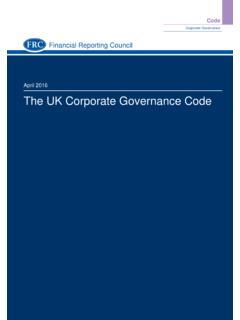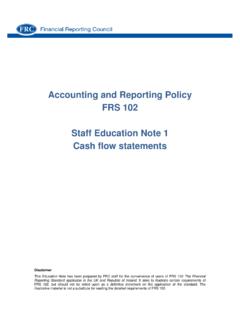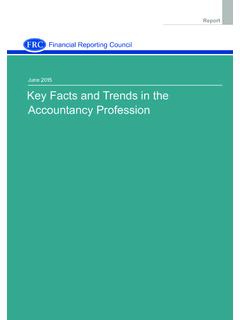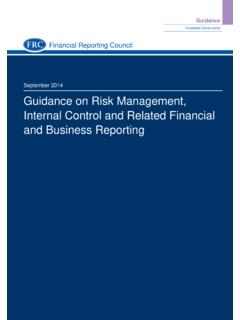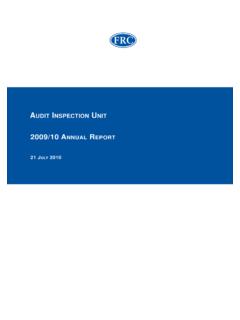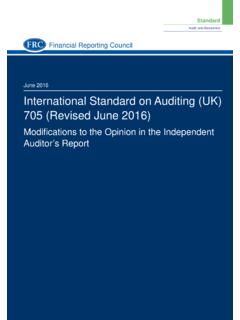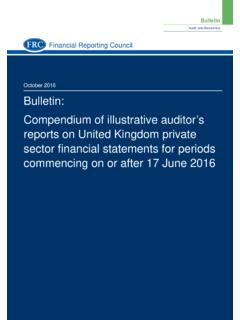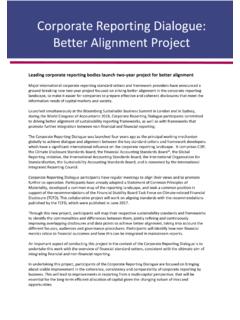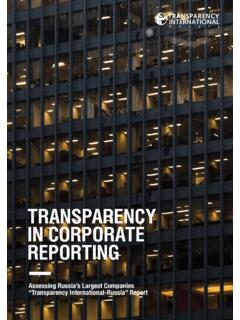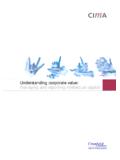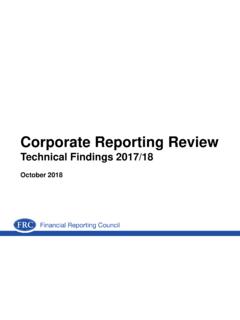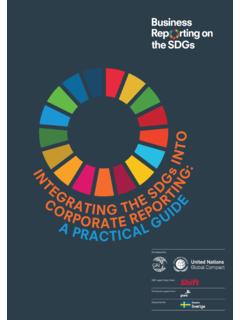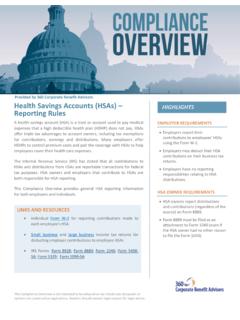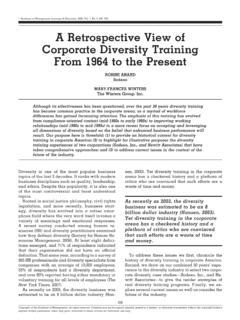Transcription of Artificial Intelligence and corporate reporting How does ...
1 Artificial Intelligence and corporate reportingHow does it measure up? January 2019 Financial reporting CouncilIntroductionThe Financial reporting Lab s Digital Present project showed that technology provided new ways for companies to interact with their stakeholders, but that many of these new mechanisms were not delivering on their promise of transformative change. The Digital Future project continues these themes and aims to understand how new and developing technologies can be used to disseminate company communications in the most efficient manner. This report, on Artificial Intelligence (AI), is the third in our series of technology deep-dives. Why AI?The Lab undertook a survey in 2016 which asked what technologies would be important for the future of corporate reporting .
2 Respondents identified AI as important for the production and consumption of corporate reporting . This report considers the case for should I read this report?This report begins with some background on AI, what it is and how it has developed. We then cover some of the potential use cases that AI has for corporate reporting . For each use case we consider what is currently being achieved and what might be achieved in the future. At the end of the report we recommend some actions for all those involved in corporate reporting . The report s appendices include some basics on different types of AI and related technologies, and links to useful material. While this report is part of a series it can also be read as a standalone document, although it does reference all the outreach and discussions undertaken throughout the wider project.
3 Artificial Intelligence and corporate reporting l How does it measure up? 1We would like to specifically thank all those who took part in interviews and roundtables for this project. The roundtables brought together technology experts, accounting, auditing, regulatory and other participants. The roundtables and interviews were used as a key input into this Introduction 1 Quick read 2 Section 1 Artificial Intelligence basics 4 What is AI? 5 AI in the real world 6 Section 2 Artificial Intelligence and corporate reporting 8 The nature of corporate reporting and reporting process challenges 9 AI and the production of corporate reporting 10 AI and the distribution of corporate reporting 13 AI and the consumption of corporate reporting 15 Section 3 Conclusions and actions 17 AI reporting : actions and questions 18 Next steps?
4 19 Section 4 Appendices 20 AI in more detail 21 Links 251AI basics2AI & corporate reporting3 Conclusions & actions4 Appendix AI in more detailQuick read1AI basics2AI & corporate reporting3 Conclusions & actions4 Appendix AI in more detailQuick readArtificial Intelligence and corporate reporting l How does it measure up? 2 Quick readIntroductionAI has long featured in future predictions about the imminent evolution of the workplace. But that future does not often consider the impact that AI might have on corporate reporting . This report, on AI in corporate reporting , is the third in our series of technology deep-dives (following on from XBRL and Blockchain). In this, and each deep-dive report, we use our digital reporting framework to explore how different technologies might impact corporate reporting production, distribution and is AI?
5 To put it simply, AI is a branch of computer science that deals with the creation and research of human-like Intelligence in machines. However, it has recently taken on a much broader meaning and now acts somewhat as shorthand for a range of different technologies and techniques (from robotic process automation, to machine learning and natural language processing) that represent the current leading edge of computerisation and automation. It is this wider range of AI and related technologies (which we collectively refer to as AI ) that we look at in this does it make sense to use AI?While one could theorise how AI might fit into almost any process, it is fair to say that most current adoptions of AI are more akin to the next stage of automation or optimisation, building upon Enterprise Resource Planning (ERP) and other systems rather than what the public may think of as AI.
6 The relatively task-focused nature of current AI indicates it is best suited to certain situations and processes where the level of repetition/standardisation and the amount of data and information mean that it is difficult for a human to undertake the task efficiently or s qualities:Means that AI can be useful when:Which creates opportunities to do things more:Ability to repeat processes and tasks quickly, completely and process is highly routine and elements of judgement can be expressed as sets of to process, structure and analyse large amounts of is too much information for a human to consider on a consistent and thorough basis or devoid of human and judgementWhilst ultimately many would like to use AI to fully automate human judgement, there are limited examples of true judgement focused AI in real world application.
7 This is perhaps a reflection of the fact that it is not technology alone which drives adoption, it is also about trust and control. There is need for AI to build trust with business, regulators and other stakeholders before it can be applied on true judgement, and developing that trust might also need each stakeholder to first improve their understanding and in actionAI is already being used within business and by consumers, from Google s use of AI to recognise and organise images based on search, to more basic customer service chatbots. However, many of the current applications of AI could be categorised as focused on sourcing and structuring of data, the implementation of complex rules and processes, or a combination of the two. Whilst a number of AI applications exist, this report addresses the question of where AI might feature in the corporate reporting and corporate reportingCorporate reporting is a mechanism to create trust and transparency in a company s financial position and performance.
8 It does this through the rules, regulations, assurance requirements and communications practices that are focused on the annual report and other regulatory documents. While the corporate reporting process is both highly complex and effective, there are challenges. Three specific challenges that we use to explore the potential for AI are: The efficiency of recording and aggregating transactions, across multiple entities, and then turning that data into an external communication; The efficiency and effectiveness of providing internal or external assurance over the resulting communication; and The effectiveness of consuming the information reported by, and about, the company and translating information into insight and ultimately into AI the answer? Our review suggests that AI is potentially, and eventually, the there are usually a number of manual processes involved in producing corporate reports which limit the potential for AI, for now, there are already use cases for the production, distribution and consumption of reporting .
9 Artificial Intelligence and corporate reporting l How does it measure up? 31AI basics2AI & corporate reporting3 Conclusions & actions4 Appendix AI in more detailQuick readAI in production, distribution and consumptionTaking company data from across an organisation, aggregating it into a single communication, then distributing it to an audience of investors, who want to analyse and combine it with other external information, is a complex process. Because it is complex, it typically involves large numbers of people at each stage. AI, and its related technologies, provide opportunities to drive efficiencies and enhance effectiveness. Potential uses for AI include:Production AI can enhance efficiency by replacing mechanistic human processing of underlying transactions and transforming that data into accounting and management information; ultimately feeding into annual AI can efficiently and effectively support auditors and boards in the internal and external validation processes needed to ensure that annual reports are credible and Investors are already using AI to enhance effectiveness of investment analysis by extracting meaning and value not only from company reporting but also from various sources of alternative data.
10 Whilst each of the use cases are independent, they all rely on two things: quality corporate data and a mix of accounting, technology and governance on dataThe quality of company financial and accounting data is critical to the development of AI for finance. Therefore, it is important to remain data smart and consider both the risks and opportunities that AI has to offer. Those thinking about adopting AI as part of the financial reporting process should consider: What data was used to train the system, where did it come from, how was quality and lack of bias ensured? Are there opportunities in accounting changes (such as IFRS 15 and 16) to gather and optimise information for AI? If the system is external to the company, what is happening to the company s data and the learning derived from that data?

